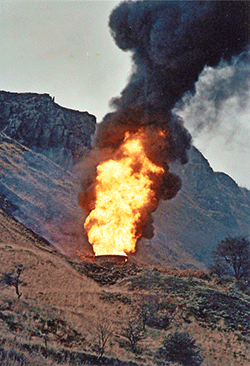Twenty-six years later, temperatures of a very different kind saw Summit Tunnel back in the news after the derailment of TransPennine Express’s three-car 0038 Manchester Airport-York service caused by ice.
TransPennine Express 185144 was the first train to use the tunnel in over three days due to the Christmas period and at 0123 on December 28 2016 struck a piece of ice weighing between 20 and 25 tonnes while travelling at 57mph.
The impact lifted the wheels of the front bogie into the air, which while still attached to the train returned to ground nine metres further on to the left of the running rails.
None of the other wheels were derailed and the train ran for a further 254 metres with the emergency brakes applied, skirting the tunnel wall in several places.
Knowing the northern portal to be only a quarter of a mile distant and failing to receive a signal on the train’s radio, the driver left the headlights on as a hazard warning and walked to the nearest signal with a telephone.
Track circuit operating clips placed by the guard ensured signals at both tunnel portals were set to danger and emergency services were summoned.
By 0213 all three emergency services and Network Rail mobile operations staff were on site to prepare for the evacuation of 45 passengers who, although unharmed, were sat in fully lit but unheated carriages.
At 0345, just before the evacuation was about to begin, ice fell from a ventilation shaft on to the roof of the second vehicle, leaving passengers shaken.
They then congregated in the leading car.
After removing ice hanging precariously above the evacuation route, firefighters from the West Yorkshire Fire Service completed the evacuation by 0440 and passengers were taken onward by bus from Walsden station.
Later that day the train was re-railed and moved under its own power back to Ardwick Depot running at a maximum speed of 40mph, where repairs were made to its damaged windscreen, coupler and bodywork.
A Network Rail road-rail excavator removed the fallen ice and the tunnel re-opened at 2300 with only minor damage to the track.
The ice block, which had formed in a ventilation shaft during a long period of cold weather before thawing and fouling the line, had not been identified as a risk by NR in the tunnel’s routine maintenance regime. The lack of an inspection before train services resumed after a three-day gap compelled the Rail Accident Investigation Branch to recommend NR put in place measures to check that structures are safe to use after dormant periods, and that cold weather and thaw conditions be taken into account by more robust weather management processes.
Of course, while the tunnel was built to survive the ravages of time, it is unlikely that fire was ever a principal design criterion for Victorian tunnellers.
Petrol was not a major fuel source in 1838 and so the structure’s resilience to fire is almost certainly coincidental rather than intentional.
The ventilation shafts that so fortunately provided an alternative exit point for ignited vapour enabled firefighters to make their escape, but again this was probably more through luck than judgement as their original purpose had become largely redundant following the withdrawal of steam traction.
But lacking the foresight to predict the fiery events of December 1984 makes Barnard Dickinson’s words all the more poignant, and March 1 2016 a very happy birthday indeed for Summit Tunnel.
- This feature was published in RAIL 797 on March 30 2016















Login to comment
Comments
Rich - 20/12/2021 11:24
Amazing story - worthy of a movie adaptation.
James - 30/12/2021 11:05
I notice no me.ntion if the tireless work by the Salvation Army to provide food and drink to all those involved on the West Yorkshire side of the tunnel. Greater Mancher FS had their own arrangements but West Yorkshire were often catered for by the Salvation Army.